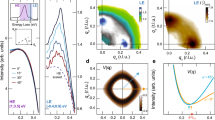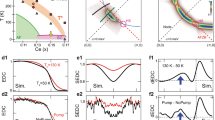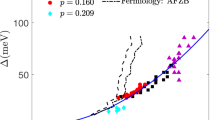Abstract
One of the pivotal questions in the physics of high-temperature superconductors is whether the low-energy dynamics of the charge carriers is mediated by bosons with a characteristic timescale. This issue has remained elusive as electronic correlations are expected to greatly accelerate the electron–boson scattering processes, confining them to the very femtosecond timescale that is hard to access even with state-of-the-art ultrafast techniques. Here we simultaneously push the time resolution and frequency range of transient reflectivity measurements up to an unprecedented level, enabling us to directly observe the ∼16 fs build-up of the effective electron–boson interaction in hole-doped copper oxides. This extremely fast timescale is in agreement with numerical calculations based on the t–J model and the repulsive Hubbard model, in which the relaxation of the photo-excited charges is achieved via inelastic scattering with short-range antiferromagnetic excitations.
This is a preview of subscription content, access via your institution
Access options
Subscribe to this journal
Receive 12 print issues and online access
$209.00 per year
only $17.42 per issue
Buy this article
- Purchase on Springer Link
- Instant access to full article PDF
Prices may be subject to local taxes which are calculated during checkout



Similar content being viewed by others
References
Lee, P. A., Nagaosa, N. & Wen, X-G. Doping a Mott insulator: Physics of high-temperature superconductivity. Rev. Mod. Phys. 78, 17–85 (2006).
Anderson, P. W. Is there glue in cuprate superconductors? Science 316, 1705–1707 (2007).
Scalapino, D. J. A common thread: The pairing interaction for unconventional superconductors. Rev. Mod. Phys. 84, 1383–1417 (2012).
Monthoux, P., Pines, D. & Lonzarich, G. G. Superconductivity without phonons. Nature 450, 1177–1183 (2007).
Gull, E. & Millis, A. J. Pairing glue in the two-dimensional Hubbard model. Phys. Rev. B 90, 041110 (2014).
Orenstein, J. Ultrafast spectroscopy in quantum materials. Phys. Today 65(9), 44–50 (2012).
Gadermaier, C. et al. Electron–phonon coupling in high-temperature cuprate superconductors determined from electron relaxation rates. Phys. Rev. Lett. 105, 257001 (2010).
Gadermaier, C. et al. Strain-induced enhancement of the electron energy relaxation in strongly correlated superconductors. Phys. Rev. X 4, 011056 (2014).
Dal Conte, S. et al. Disentangling the electronic and phononic glue in a high-Tc superconductor. Science 335, 1600–1603 (2012).
Brida, D. et al. Few-optical-cycle pulses tunable from the visible to the mid-infrared by optical parametric amplifiers. J. Opt. 12, 013001 (2010).
Eisaki, H. et al. Effect of chemical inhomogeneity in bismuth-based copper oxide superconductors. Phys. Rev. B 69, 064512 (2004).
Cilento, F. et al. Photo-enhanced antinodal conductivity in the pseudogap state of high-Tc cuprates. Nature Commun. 5, 4353 (2014).
Van Heumen, E. et al. Optical determination of the relation between the electron–boson coupling function and the critical temperature in high-Tc cuprates. Phys. Rev. B 79, 184512 (2009).
Novelli, F. et al. Witnessing the formation and relaxation of dressed quasi-particles in a strongly correlated electron system. Nature Commun. 5, 5112 (2014).
Perfetti, L. et al. Ultrafast electron relaxation in superconducting Bi2Sr2CaCu2O8+δ by time-resolved photoelectron spectroscopy. Phys. Rev. Lett. 99, 197001 (2007).
Kaindl, R. A. et al. Ultrafast mid-infrared response of YBa2Cu3O7−δ . Science 287, 470–473 (2000).
Coslovich, G. et al. Competition between the pseudogap and superconducting states of Bi2Sr2Ca0.92Y0.08Cu2O8+δ single crystals revealed by ultrafast broadband optical reflectivity. Phys. Rev. Lett. 110, 107003 (2013).
Baranov, V. V. & Kabanov, V. V. Theory of electronic relaxation in a metal excited by an ultrashort optical pump. Phys. Rev. B 89, 125102 (2014).
Dahm, T. et al. Strength of the spin-fluctuation-mediated pairing interaction in a high-temperature superconductor. Nature Phys. 5, 217–221 (2009).
Le Tacon, M. et al. Intense paramagnon excitations in a large family of high-temperature superconductors. Nature Phys. 7, 725–730 (2011).
Fujita, M. et al. Progress in neutron scattering studies of spin excitations in high-Tc cuprates. J. Phys. Soc. Jpn 81, 011007 (2012).
Dean, M. P. M. et al. High-energy magnetic excitations in the cuprate superconductor Bi2Sr2CaCu2O8: Towards a unified description of its electronic and magnetic degrees of freedom. Phys. Rev. Lett. 110, 147001 (2013).
Le Tacon, M. et al. Dispersive spin excitations in highly overdoped cuprates revealed by resonant inelastic X-ray scattering. Phys. Rev. B 88, 020501 (2013).
Dean, M. P. M. et al. Persistence of magnetic excitations in La2−xSrxCuO4 from the undoped insulator to the heavily overdoped non-superconducting metal. Nature Mater. 12, 1019–1023 (2013).
Singla, R. et al. Photoinduced melting of the orbital order in La0.5Sr1.5MnO4 measured with 4-fs laser pulses. Phys. Rev. B 88, 075107 (2013).
Mierzejewski, M., Vidmar, L., Bonča, J. & Prelovšek, P. Nonequilibrium quantum dynamics of a charge carrier doped into a Mott insulator. Phys. Rev. Lett. 106, 196401 (2011).
Golež, D., Bonča, J., Mierzejewski, M. & Vidmar, L. Mechanism of ultrafast relaxation of a photo-carrier in antiferromagnetic spin background. Phys. Rev. B 89, 165118 (2014).
Eckstein, M. & Werner, P. Ultra-fast photo-carrier relaxation in Mott insulators with short-range spin correlations. Preprint at http://arxiv.org/abs/1410.3956 (2014).
Kong, Y., Dolgov, O. V., Jepsen, O. & Andersen, O. K. Electron–phonon interaction in the normal and superconducting states of MgB2 . Phys. Rev. B 64, 020501 (2001).
Della Valle, G., Conforti, M., Longhi, S., Cerullo, G. & Brida, D. Real-time optical mapping of the dynamics of nonthermal electrons in thin gold films. Phys. Rev. B 86, 155139 (2012).
Elsayed-Ali, H. E., Norris, T. B., Pessot, M. A. & Mourou, G. A. Time-resolved observation of electron-phonon relaxation in copper. Phys. Rev. B 58, 1212–1215 (1987).
Allen, P. B. & Dynes, R. C. Transition temperature of strong-coupled superconductors reanalyzed. Phys. Rev. B 12, 905–922 (1975).
Allen, P. B. Theory of thermal relaxation of electrons in metals. Phys. Rev. Lett. 59, 1460–1463 (1987).
Brida, D. et al. Generation of 8.5 fs pulses at 1.3 μm for ultrabroadband pump–probe spectroscopy. Opt. Express 17, 12510 (2009).
Ono, S. & Ando, Y. Evolution of the resistivity anisotropy in Bi2Sr2−xLaxCuO6+δ single crystals for a wide range of hole doping. Phys. Rev. B 67, 104512 (2003).
Peets, D. C. et al. Tl2Ba2CuO6+δ brings spectroscopic probes deep into the overdoped regime of the high-Tc cuprates. New J. Phys. 9, 28 (2007).
Zhigadlo, N. D. et al. Influence of Mg deficiency on crystal structure and superconducting properties in MgB2 single crystals. Phys. Rev. B 81, 054520 (2010).
Bonča, J., Maekawa, S. & Tohyama, T. Numerical approach to the low-doping regime of the t–J model. Phys. Rev. B 76, 035121 (2007).
Park, T. J. & Light, J. C. Unitary quantum time evolution by iterative Lanczos reduction. J. Chem. Phys. 85, 5870–5876 (1986).
Acknowledgements
We thank F. Cilento, G. Coslovich, D. Fausti, F. Parmigiani, D. Mihailović, P. Prelovšek, V.V. Kabanov, U. Bovensiepen, M. Eckstein, A. Avella, D. van der Marel, L. Boeri, L. de’ Medici, A. Cavalleri, D. Manske, B. Keimer and D.J. Scalapino for useful and fruitful discussions. We gratefully acknowledge D. Bonn and B. Keimer for support in the development of the MPI-UBC Tl2201OD research effort. The research activities of S.D.C., F.B, G.F., M.C. and C.G. received funding from the European Union, Seventh Framework Programme (FP7 2007-2013), under Grant No. 280555 (GO FAST). S.D.C. received financial support from Futuro through Ricerca grant No. RBFR12SW0J of the Italian Ministry of Education, University and Research. L.V. is supported by the Alexander von Humboldt Foundation. M.M. acknowledges support from the DEC-2013/09/B/ST3/01659 project of the Polish National Science Center. The Y-Bi2212UD crystal growth work was performed in M.G.’s previous laboratory at Stanford University, Stanford, CA 94305, USA, and supported by the US Department of Energy, Office of Basic Energy Sciences. The work at UBC was supported by the Max Planck—UBC Centre for Quantum Materials, the Killam, A. P. Sloan, Alexander von Humboldt, and NSERC’s Steacie Memorial Fellowships (A.D.), the Canada Research Chairs Program (A.D.), NSERC, CFI, and CIFAR Quantum Materials. M.C. is financed by the European Research Council through FP7/ERC Starting Grant SUPERBAD, Grant Agreement 240524. J.B. acknowledges support by the P1-0044 of ARRS, Slovenia and Center for Integrated Nanotechnologies, a US Department of Energy, Office of Basic Energy Sciences user facility. G.C. acknowledges support by the EC under Graphene Flagship (contract no. CNECT-ICT-604391). N.D.Z. acknowledges support from the NCCR project ‘Materials with Novel Electronic Properties’ and appreciates expert collaboration with J. Karpinski.
Author information
Authors and Affiliations
Contributions
C.G., S.D.C. and G.C. conceived the experiments. L.V., M.M. and J.B. conceived the out-of-equilibrium calculations. C.G. coordinated the research activities with input from all the coauthors, in particular S.D.C., L.V., J.B., M.M., M.C., A.D. and G.C. The broadband pump–probe set-up was designed and developed by D.B. and G.C. The time-resolved optical measurements were performed by S.D.C., G.S., S.P., L.C., D.B. and G.C. The analysis of the time-resolved data was performed by S.D.C. and C.G. The out-of-equilibrium t–J model calculations were performed by L.V., D.G., M.M. and J.B. The DMFT calculations were carried out by M.C. The Y-Bi2212 crystals were grown and characterized by H.E., M.G., R.C. and A.D. The Tl-2201 crystals were grown and characterized by L.C. The characterization and measurement of the equilibrium optical properties of the Bi2201 crystals were performed by S.L. The MgB2 crystals were grown by N.D.Z. and characterized by B.M.L. and N.D.Z. The text was written by C.G. with major input from S.D.C., L.V., M.M., J.B., F.B., G.F., M.G., S.L., M.G., M.C., A.D., D.B. and G.C. All authors extensively discussed the results and the interpretation and revised the manuscript.
Corresponding authors
Ethics declarations
Competing interests
The authors declare no competing financial interests.
Supplementary information
Supplementary Information
Supplementary Information (PDF 3907 kb)
Rights and permissions
About this article
Cite this article
Dal Conte, S., Vidmar, L., Golež, D. et al. Snapshots of the retarded interaction of charge carriers with ultrafast fluctuations in cuprates. Nature Phys 11, 421–426 (2015). https://doi.org/10.1038/nphys3265
Received:
Accepted:
Published:
Issue Date:
DOI: https://doi.org/10.1038/nphys3265
This article is cited by
-
Ab initio real-time quantum dynamics of charge carriers in momentum space
Nature Computational Science (2023)
-
Coupled electronic and magnetic excitations in the cuprates and their role in the superconducting transition
Communications Physics (2022)
-
Terahertz spectroscopy of high temperature superconductors and their photonic applications
Journal of the Korean Physical Society (2022)
-
Emergence of pseudogap from short-range spin-correlations in electron-doped cuprates
npj Quantum Materials (2020)
-
Fractons from frustration in hole-doped antiferromagnets
npj Quantum Materials (2020)



